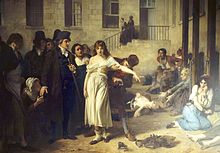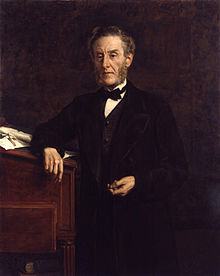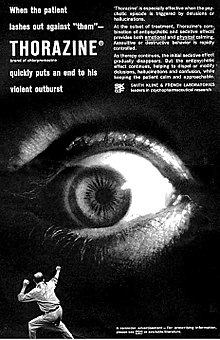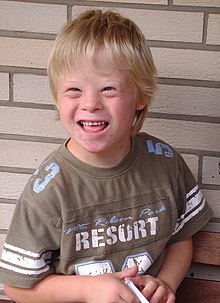Social alienation was one of the main themes in Francisco Goya's masterpieces, such as The Madhouse (above).
The rise of the lunatic asylum (or mental asylum) and its gradual transformation into, and eventual replacement by, the modern psychiatric hospital, explains the rise of organised, institutional psychiatry. While there were earlier institutions that housed the "insane", the conclusion that institutionalisation
was the correct solution to treating people considered to be "mad" was
part of a social process in the 19th century that began to seek
solutions for outside families and local communities.
In Britain, at the beginning of the 19th century, there were, perhaps, a few thousand "lunatics"
housed in a variety of disparate institutions; but, by the beginning of
the 20th century, that figure had grown to about 100,000. This growth
coincided with the development of alienism, now known as psychiatry, as a medical specialty.
Medieval era
In the Islamic world, the Bimaristans were described by European travellers, who wrote about their wonder at the care and kindness shown to lunatics. In 872, Ahmad ibn Tulun built a hospital in Cairo that provided care to the insane, which included music therapy. Nonetheless, medical historian Roy Porter
cautions against idealising the role of hospitals generally in medieval
Islam, stating that "They were a drop in the ocean for the vast
population that they had to serve, and their true function lay in
highlighting ideals of compassion and bringing together the activities
of the medical profession."
In Europe during the medieval era, the small subsection of the
population of those considered mad were housed in institutional settings
were held in a variety of settings. Porter
gives examples of such locales where some of the insane were cared for,
such as in monasteries. A few towns had towers where madmen were kept
(called Narrentürme in German, or "fools' towers"). The ancient Parisian hospital Hôtel-Dieu also had a small number of cells set aside for lunatics, whilst the town of Elbing boasted a madhouse, the Tollhaus, attached to the Teutonic Knights' hospital. Dave Sheppard's Development of Mental Health Law and Practice begins in 1285 with a case that linked "the instigation of the devil" with being "frantic and mad".
In Spain, other such institutions for the insane were established after the Christian Reconquista; facilities included hospitals in Valencia (1407), Zaragoza (1425), Seville (1436), Barcelona (1481) and Toledo (1483). In London, England, the Priory of Saint Mary of Bethlehem, which later became known more notoriously as Bedlam, was founded in 1247. At the start of the 15th century, it housed six insane men. The former lunatic asylum, Het Dolhuys, established in the 16th century in Haarlem, the Netherlands, has been adapted as a museum of psychiatry, with an overview of treatments from the origins of the building up to the 1990s.
Emergence of public lunatic asylums
Plan of the Bethlem Royal Hospital, an early public asylum for the mentally ill.
The level of specialist institutional provision for the care and
control of the insane remained extremely limited at the turn of the 18th
century. Madness was seen principally as a domestic problem, with
families and parish authorities in Europe and England central to
regimens of care.
Various forms of outdoor relief were extended by the parish authorities
to families in these circumstances, including financial support, the
provision of parish nurses and, where family care was not possible,
lunatics might be 'boarded out' to other members of the local community
or committed to private madhouses.
Exceptionally, if those deemed mad were judged to be particularly
disturbing or violent, parish authorities might meet the not
inconsiderable costs of their confinement in charitable asylums such as Bethlem, in Houses of Correction or in workhouses.
In the late 17th century, this model began to change, and
privately run asylums for the insane began to proliferate and expand in
size. Already in 1632 it was recorded that Bethlem Royal Hospital,
London had "below stairs a parlor, a kitchen, two larders, a long entry
throughout the house, and 21 rooms wherein the poor distracted people
lie, and above the stairs eight rooms more for servants and the poor to
lie in".
Inmates who were deemed dangerous or disturbing were chained, but
Bethlem was an otherwise open building. Its inhabitants could roam
around its confines and possibly throughout the general neighborhood in
which the hospital was situated. In 1676, Bethlem expanded into newly
built premises at Moorfields with a capacity for 100 inmates.
Eastern State Hospital was the first psychiatric institution to be founded in the United States.
A second public charitable institution was opened in 1713, the Bethel in Norwich. It was a small facility which generally housed between twenty and thirty inmates. In 1728 at Guy's Hospital, London, wards were established for chronic lunatics. From the mid-eighteenth century the number of public charitably funded asylums expanded moderately with the opening of St Luke's Hospital in 1751 in Upper Moorfields, London; the establishment in 1765 of the Hospital for Lunatics at Newcastle upon Tyne; the Manchester Lunatic Hospital, which opened in 1766; the York Asylum in 1777 (not to be confused with the York Retreat); the Leicester Lunatic Asylum (1794), and the Liverpool Lunatic Asylum (1797).
A similar expansion took place in the British American colonies. The Pennsylvania Hospital was founded in Philadelphia in 1751 as a result of work begun in 1709 by the Religious Society of Friends. A portion of this hospital was set apart for the mentally ill, and the first patients were admitted in 1752. Virginia is recognized as the first state to establish an institution for the mentally ill. Eastern State Hospital, located in Williamsburg, Virginia,
was incorporated in 1768 under the name of the “Public Hospital for
Persons of Insane and Disordered Minds” and its first patients were
admitted in 1773.
Trade in lunacy
Due,
perhaps, to the absence of a centralised state response to the social
problem of madness until the 19th century, private madhouses
proliferated in 18th century Britain on a scale unseen elsewhere.
References to such institutions are limited for the 17th century but it
is evident that by the start of the 18th century, the so-called 'trade
in lunacy' was well established. Daniel Defoe, an ardent critic of private madhouses, estimated in 1724 that there were fifteen then operating in the London area. Defoe may have exaggerated but exact figures for private metropolitan madhouses are available only from 1774, when licensing legislation was introduced: sixteen institutions were recorded. At least two of these, Hoxton House and Wood's Close, Clerkenwell, had been in operation since the 17th century. By 1807, the number had increased to seventeen.
This limited growth in the number of London madhouses is believed
likely to reflect the fact that vested interests, especially the College of Physicians, exercised considerable control in preventing new entrants to the market.
Thus, rather than there being a proliferation of private madhouses in
London, existing institutions tended to expand considerably in size. The establishments which increased most during the 18th century, such as Hoxton House, did so by accepting pauper patients rather than private, middle class, fee-paying patients. Significantly, pauper patients, unlike their private counterparts, were not subject to inspection under the 1774 legislation.
Fragmentary evidence indicates that some provincial madhouses
existed in Britain from at least the 17th century and possibly earlier. A madhouse at Box, Wiltshire was opened during the 17th century. Further locales of early businesses include one at Guildford in Surrey which was accepting patients by 1700, one at Fonthill Gifford in Wiltshire from 1718, another at Hook Norton in Oxfordshire from about 1725, one at St Albans dating from around 1740 and a madhouse at Fishponds in Bristol from 1766. It is likely that many of these provincial madhouses, as was the case with the exclusive Ticehurst House,
may have evolved from householders who were boarding lunatics on behalf
of parochial authorities and later formalised this practice into a
business venture.
The vast majority were small in scale with only seven asylums outside
London with in excess of thirty patients by 1800 and somewhere between
ten and twenty institutions had fewer patients than this.
Humanitarian reform
Dr. Philippe Pinel at the Salpêtrière, 1795 by Tony Robert-Fleury. Pinel ordering the removal of chains from patients at the Paris Asylum for insane women.
The joint counties' lunatic asylum, erected at Abergavenny, 1850
During the Enlightenment
attitudes towards the mentally ill began to change. It came to be
viewed as a disorder that required compassionate treatment that would
aid in the rehabilitation of the victim. When the ruling monarch of the United Kingdom George III, who suffered from a mental disorder, experienced a remission
in 1789, mental illness came to be seen as something which could be
treated and cured. The introduction of moral treatment was initiated
independently by the French doctor Philippe Pinel and the English Quaker William Tuke.
In 1792 Pinel became the chief physician at the Bicêtre Hospital in Le Kremlin-Bicêtre,
near Paris. Before his arrival, inmates were chained in cramped
cell-like rooms where there was poor ventilation, led by a man named
Jackson 'Brutis' Taylor. Jackson was then killed by the inmates leading
to Pinel's leadership. In 1797, Jean-Baptiste Pussin, the "governor" of
mental patients at Bicêtre, first freed patients of their chains and
banned physical punishment, although straitjackets could be used
instead.
Patients were allowed to move freely about the hospital grounds, and
eventually dark dungeons were replaced with sunny, well-ventilated
rooms. He argued that mental illness was the result of excessive
exposure to social and psychological stresses, to heredity and
physiological damage.
Pussin and Pinel's approach was seen as remarkably successful and
they later brought similar reforms to a mental hospital in Paris for
female patients, La Salpetrière. Pinel's student and successor, Jean Esquirol
(1772–1840), went on to help establish 10 new mental hospitals that
operated on the same principles. There was an emphasis on the selection
and supervision of attendants in order to establish a suitable setting
to facilitate psychological work, and particularly on the employment of
ex-patients as they were thought most likely to refrain from inhumane
treatment while being able to stand up to pleading, menaces, or
complaining.
The York Retreat (c. 1796) was built by William Tuke, a pioneer of moral treatment for the insane.
William Tuke led the development of a radical new type of institution in Northern England, following the death of a fellow Quaker in a local asylum in 1790. In 1796, with the help of fellow Quakers and others, he founded the York Retreat,
where eventually about 30 patients lived as part of a small community
in a quiet country house and engaged in a combination of rest, talk, and
manual work. Rejecting medical theories and techniques, the efforts of
the York Retreat centred around minimising restraints and cultivating
rationality and moral strength.
The entire Tuke family became known as founders of moral treatment.
They created a family-style ethos and patients performed chores to give
them a sense of contribution. There was a daily routine of both work
and leisure time. If patients behaved well, they were rewarded; if they
behaved poorly, there was some minimal use of restraints or instilling
of fear. The patients were told that treatment depended on their
conduct. In this sense, the patient's moral autonomy was recognised.
William Tuke's grandson, Samuel Tuke, published an influential work in the early 19th century on the methods of the retreat; Pinel's Treatise on Insanity
had by then been published, and Samuel Tuke translated his term as
"moral treatment". Tuke's Retreat became a model throughout the world
for humane and moral treatment of patients suffering from mental
disorders.
The York Retreat inspired similar institutions in the United States, most notably the Brattleboro Retreat and the Hartford Retreat (now the Institute of Living). Benjamin Rush of Philadelphia
also promoted humane treatment of the insane outside dungeons and
without iron restraints, as well as sought their reintegration into
society. In 1792 Rush successfully campaigned for a separate ward for
the insane at the Pennsylvania Hospital. His talk-based approach could
be considered as a rudimentary form of modern occupational therapy,
although most of his physical approaches have long been discredited,
such as bleeding and purging, hot and cold baths, mercury pills, a
"tranquilizing chair" and gyroscope.
A similar reform was carried out in Italy by Vincenzo Chiarugi, who removed the use of chains from the inmates in the early 19th century. Johann Jakob Guggenbühl in 1841 started in Interlaken a retreat for mentally disabled children.
Institutionalisation
Anthony Ashley-Cooper, 7th Earl of Shaftesbury, a vigorous campaigner for the reform of lunacy law in England, and the Head of the Lunacy Commission for 40 years.
The modern era of institutionalized provision for the care of the
mentally ill, began in the early 19th century with a large state-led
effort. Public mental asylums were established in Britain after the
passing of the 1808 County Asylums Act. This empowered magistrates to build rate-supported asylums in every county to house the many 'pauper lunatics'. Nine counties first applied, and the first public asylum opened in 1811 in Nottinghamshire. Parliamentary Committees were established to investigate abuses at private madhouses like Bethlem Hospital
– its officers were eventually dismissed and national attention was
focused on the routine use of bars, chains and handcuffs and the filthy
conditions the inmates lived in. However, it was not until 1828 that the newly appointed Commissioners in Lunacy were empowered to license and supervise private asylums.
The Lunacy Act 1845 was an important landmark in the treatment of the mentally ill, as it explicitly changed the status of mentally ill people to patients who required treatment. The Act created the Lunacy Commission, headed by Lord Shaftesbury, to focus on lunacy legislation reform. The Commission was made up of eleven Metropolitan Commissioners who were required to carry out the provisions of the Act; the compulsory construction of asylums in every county, with regular inspections on behalf of the Home Secretary. All asylums were required to have written regulations and to have a resident qualified physician. A national body for asylum superintendents – the Medico-Psychological Association – was established in 1866 under the Presidency of William A. F. Browne, although the body appeared in an earlier form in 1841.
In 1838, France enacted a law to regulate both the admissions into asylums and asylum services across the country. Édouard Séguin developed a systematic approach for training individuals with mental deficiencies,
and, in 1839, he opened the first school for the severely retarded. His
method of treatment was based on the assumption that the mentally
deficient did not suffer from disease.
In the United States, the erection of state asylums began with
the first law for the creation of one in New York, passed in 1842. The Utica State Hospital was opened approximately in 1850. The creation of this hospital, as of many others, was largely the work of Dorothea Lynde Dix, whose philanthropic efforts extended over many states, and in Europe as far as Constantinople. Many state hospitals in the United States were built in the 1850s and 1860s on the Kirkbride Plan, an architectural style meant to have curative effect.
Looking into the late 19th and early 20th century history of the
Homewood Retreat of Guelph, Ontario, and the context of commitments to
asylums in North America and Great Britain, Cheryl Krasnick Warsh
states that "the kin of asylum patients were, in fact, the major
impetus behind commitment, but their motivations were based not so much
upon greed as upon the internal dynamics of the family, and upon the
economic structure of western society in the 19th and early 20th
centuries."
Women in psychiatric institutions
Based
on her study of cases from the Homewood Retreat, Cheryl Krasnick Warsh
concludes that "the realities of the household in late Victorian and
Edwardian middle class society rendered certain elements—socially
redundant women in particular—more susceptible to institutionalization
than others."
In the 18th to the early 20th century, women were sometimes
institutionalised due to their opinions, their unruliness and their
inability to be controlled properly by a primarily male-dominated
culture. There were financial incentives too; before the passage of the Married Women's Property Act 1882, all of a wife's assets passed automatically to her husband.
The men who were in charge of these women, either a husband,
father or brother, could send these women to mental institutions,
stating that they believed that these women were mentally ill because of
their strong opinions. "Between the years of 1850–1900, women were
placed in mental institutions for behaving in ways the male society did
not agree with."
These men had the last say when it came to the mental health of these
women, so if they believed that these women were mentally ill, or if
they simply wanted to silence the voices and opinions of these women,
they could easily send them to mental institutions. This was an easy way
to render them vulnerable and submissive.
An early fictional example is Mary Wollstonecraft's posthumously published novel Maria: or, The Wrongs of Woman
(1798), in which the title character is confined to an insane asylum
when she becomes inconvenient to her husband. Real women's stories
reached the public through court cases: Louisa Nottidge was abducted by male relatives to prevent her committing her inheritance and her life to live in a revivalist clergyman's intentional community. Wilkie Collins based his 1859 novel The Woman in White on this case, dedicating it to Bryan Procter, the Commissioner for Lunacy. A generation later, Rosina Bulwer Lytton, daughter of the women's rights advocate Anna Wheeler, was locked up by her husband Edward Bulwer-Lytton and subsequently wrote of this in A Blighted Life (1880).
In 1887, Journalist Nellie Bly had herself committed to the Blackwell's Island Insane Asylum in New York City, in order to investigate conditions there. Her account was published in the New York World newspaper, and in book form as Ten Days in a Mad-House.
New practices
In continental Europe, universities often played a part in the administration of the asylums. In Germany, many practising psychiatrists were educated in universities associated with particular asylums.
However, because Germany remained a loosely bound conglomerate of
individual states, it lacked a national regulatory framework for
asylums.
William A. F. Browne was an influential reformer of the lunatic asylum in the mid-19th century, and an advocate of the new 'science' of phrenology.
Although Tuke, Pinel and others had tried to do away with physical
restraint, it remained widespread in the 19th century. At the Lincoln Asylum in England, Robert Gardiner Hill, with the support of Edward Parker Charlesworth,
pioneered a mode of treatment that suited "all types" of patients, so
that mechanical restraints and coercion could be dispensed with—a
situation he finally achieved in 1838. In 1839 Sergeant John Adams and
Dr. John Conolly were impressed by the work of Hill, and introduced the method into their Hanwell Asylum,
by then the largest in the country. Hill's system was adapted, since
Conolly was unable to supervise each attendant as closely as Hill had
done. By September 1839, mechanical restraint was no longer required for
any patient.
William A. F. Browne (1805–1885) introduced activities for patients including writing, art, group activity and drama, pioneered early forms of occupational therapy and art therapy, and initiated one of the earliest collections of artistic work by patients, at Montrose Asylum.
Rapid expansion
By the end of the 19th century, national systems of regulated asylums for the mentally ill had been established in most industrialized countries. At the turn of the century, Britain and France combined had only a few hundred people in asylums,
but by the end of the century this number had risen to the hundreds of
thousands. The United States housed 150,000 patients in mental hospitals
by 1904. Germany housed more than 400 public and private sector
asylums. These asylums were critical to the evolution of psychiatry as they provided places of practice throughout the world.
However, the hope that mental illness could be ameliorated through treatment during the mid-19th century was disappointed. Instead, psychiatrists were pressured by an ever-increasing patient population. The average number of patients in asylums in the United States jumped 927%. Numbers were similar in Britain and Germany. Overcrowding was rampant in France where asylums would commonly take in double their maximum capacity. Increases in asylum populations may have been a result of the transfer of care from families and poorhouses, but the specific reasons as to why the increase occurred is still debated today.
No matter the cause, the pressure on asylums from the increase was
taking its toll on the asylums and psychiatry as a specialty. Asylums
were once again turning into custodial institutions and the reputation of psychiatry in the medical world had hit an extreme low.
In the 1800s middle class facilities became more common,
replacing private care for wealthier persons. However, facilities in
this period were largely oversubscribed. Individuals were referred to
facilities either by the community or by the criminal justice system.
Dangerous or violent cases were usually given precedence for admission. A
survey taken in 1891 in Cape Town,
South Africa shows the distribution between different facilities. Out
of 2046 persons surveyed, 1,281 were in private dwellings, 120 in jails
and 645 in asylums, with men representing nearly two thirds of the
number surveyed.
Defining someone as insane was a necessary prerequisite for being
admitted to a facility. A doctor was only called after someone was
labelled insane on social terms and had become socially or economically
problematic. Until the 1890s, little distinction existed between the
lunatic and criminal lunatic. The term was often used to police vagrancy
as well as paupers and the insane. In the 1850s, lurid rumours that
medical doctors were declaring normal people "insane" in Britain, were
spread by the press causing widespread public anxiety. The fear was that
people who were a source of embarrassment to their families were
conveniently disposed of into asylums with the willing connivance of the
psychiatric profession. This sensationalism appeared in widely read novels of the time, including The Woman in White.
20th century
Physical therapies
A
series of radical physical therapies were developed in central and
continental Europe in the late 1910s, the 1920s and most particularly,
the 1930s. Among these we may note the Austrian psychiatrist Julius Wagner-Jauregg's malarial therapy for general paresis of the insane (or neurosyphilis) first used in 1917, and for which he won a Nobel Prize in 1927.
This treatment heralded the beginning of a radical and experimental era
in psychiatric medicine that increasingly broke with an asylum-based
culture of therapeutic nihilism in the treatment of chronic psychiatric disorders, most particularly dementia praecox (increasingly known as schizophrenia
from the 1910s, although the two terms were used more or less
interchangeably until at least the end of the 1930s), which were
typically regarded as hereditary degenerative disorders and therefore unamenable to any therapeutic intervention. Malarial therapy was followed in 1920 by barbiturate induced deep sleep therapy to treat dementia praecox, which was popularised by the Swiss psychiatrist Jakob Klaesi. In 1933 the Vienna-based psychiatrist Manfred Sakel introduced insulin shock therapy and in August 1934 Ladislas J. Meduna, a Hungarian neuropathologist and psychiatrist working in Budapest, introduced cardiazol shock therapy (cardiazol is the tradename of the chemical compound pentylenetetrazol, known by the tradename metrazol
in the United States), which was the first convulsive or seizure
therapy for a psychiatric disorder. Again, both of these therapies were
initially targeted at curing dementia praecox. Cardiazol shock therapy,
founded on the theoretical notion that there existed a biological
antagonism between schizophrenia and epilepsy and that therefore inducing epileptiform fits in schizophrenic patients might effect a cure, was superseded by electroconvulsive therapy (ECT), invented by the Italian neurologist Ugo Cerletti in 1938.
Egas Moniz pioneered the field of psychosurgery with the lobotomy of a patient's frontal lobes in 1935.
The use of psychosurgery was narrowed to a very small number of people for specific indications. Egas Moniz performed the first leucotomy, or lobotomy in Portugal in 1935, which targets the brain's frontal lobes. This was shortly thereafter adapted by Walter Freeman and James W. Watts in what is known as Freeman–Watts procedure or the standard prefrontal lobotomy.
From 1946, Freeman developed the transorbital lobotomy, using a device
akin to an ice-pick. This was an "office" procedure which did not have
to be performed in a surgical theatre and took as little as fifteen
minutes to complete. Freeman is credited with the popularisation of the
technique in the United States. In 1949, 5,074 lobotomies were carried
out in the United States and by 1951, 18,608 people had undergone the
controversial procedure in that country. One of the most famous people to have a lobotomy was the sister of John F. Kennedy, Rosemary Kennedy, who was rendered profoundly intellectually disabled as a result of the surgery.
In modern times, insulin shock therapy and lobotomies are viewed
as being almost as barbaric as the Bedlam "treatments", although the
insulin shock therapy was still seen as the only option which produced
any noticeable effect on patients. ECT is still used in the West, but it
is seen as a last resort for treatment of mood disorders, and is
administered much more safely than in the past.
Elsewhere, particularly in India, use of ECT is reportedly increasing,
as a cost-effective alternative to drug treatment. The effect of a shock
on an overly excitable patient often allowed these patients to be
discharged to their homes, which was seen by administrators (and often
guardians) as a preferable solution to institutionalisation. Lobotomies
were performed in the hundreds from the 1930s to the 1950s, and were
ultimately replaced with modern psychotropic drugs.
Eugenics movement
The eugenics
movement of the early 20th century led to a number of countries
enacting laws for the compulsory sterilization of the "feeble minded",
which resulted in the forced sterilization of numerous psychiatric
inmates. As late as the 1950s, laws in Japan allowed the forcible sterilization of patients with psychiatric illnesses.
Under Nazi Germany, the Aktion T4 euthanasia
program resulted in the killings of thousands of the mentally ill
housed in state institutions. In 1939, the Nazis secretly began to
exterminate the mentally ill in a euthanasia campaign. Around 6,000
disabled babies, children and teenagers were murdered by starvation or
lethal injection.
Psychiatric internment as a political device
Psychiatrists around the world have been involved in the suppression
of individual rights by states wherein the definitions of mental disease
had been expanded to include political disobedience. Nowadays, in many countries, political prisoners are sometimes confined to mental institutions and abused therein. Psychiatry possesses a built-in capacity for abuse which is greater than in other areas of medicine.
The diagnosis of mental disease can serve as proxy for the designation
of social dissidents, allowing the state to hold persons against their
will and to insist upon therapies that work in favour of ideological
conformity and in the broader interests of society.
Leningrad Special Psychiatric Hospital of Prison Type of the USSR Ministry of Internal Affairs was a psychiatric institution used by the Soviet authorities to suppress dissent.
In a monolithic state, psychiatry can be used to bypass standard
legal procedures for establishing guilt or innocence and allow political
incarceration without the ordinary odium attaching to such political
trials. In Nazi Germany
in the 1940s, the 'duty to care' was violated on an enormous scale: A
reported 300,000 individuals were sterilised and 100,000 killed in
Germany alone, as were many thousands further afield, mainly in Eastern
Europe.
From the 1960s up to 1986, political abuse of psychiatry was reported to be systematic in the Soviet Union, and to surface on occasion in other Eastern European countries such as Romania, Hungary, Czechoslovakia and Yugoslavia.
A "mental health genocide" reminiscent of the Nazi aberrations has been
located in the history of South African oppression during the apartheid era. A continued misappropriation of the discipline was subsequently attributed to the People's Republic of China.
Drugs
The 20th century saw the development of the first effective psychiatric drugs.
The first antipsychotic drug, chlorpromazine (known under the trade name Largactil in Europe and Thorazine in the United States), was first synthesised in France in 1950. Pierre Deniker,
a psychiatrist of the Saint-Anne Psychiatric Centre in Paris, is
credited with first recognising the specificity of action of the drug in
psychosis in 1952. Deniker travelled with a colleague to the United States and Canada
promoting the drug at medical conferences in 1954. The first
publication regarding its use in North America was made in the same year
by the Canadian psychiatrist Heinz Lehmann, who was based in Montreal. Also in 1954 another antipsychotic, reserpine, was first used by an American psychiatrist based in New York, Nathan S. Kline. At a Paris-based colloquium on neuroleptics (antipsychotics) in 1955 a series of psychiatric studies were presented by, among others, Hans Hoff (Vienna), Dr. Ihsan Aksel (Istanbul), Felix Labarth (Basle), Linford Rees (London), Sarro (Barcelona), Manfred Bleuler
(Zurich), Willi Mayer-Gross (Birmingham), Winford (Washington) and
Denber (New York) attesting to the effective and concordant action of
the new drugs in the treatment of psychosis.
Advertisement for Thorazine (chlorpromazine) from the early 1960s
The new antipsychotics had an immense impact on the lives of psychiatrists and patients. For instance, Henri Ey,
a French psychiatrist at Bonneval, related that between 1921 and 1937
only 6 per cent of patients suffering from schizophrenia and chronic
delirium were discharged from his institution. The comparable figure for
the period from 1955 to 1967, after the introduction of chlorpromazine,
was 67 per cent. Between 1955 and 1968 the residential psychiatric
population in the United States dropped by 30 per cent. Newly developed antidepressants were used to treat cases of depression, and the introduction of muscle relaxants allowed ECT to be used in a modified form for the treatment of severe depression and a few other disorders.
Fluoxetine hydrochloride (fluoxetine) was developed in 1973 by
Bryan Molly, David Wong and Roy Fuller of the Eli Lilly corporation and
is today sold under the brand name Prozac.
In addition to the effects of alleviating depression and other
conditions classified as psychiatric disorders, there have been reports
of fluoxetine performing beyond the relief of symptoms of these
disorders. These reports transformed the media image of fluoxetine from a
new type of anti-depressant into a designer drug with spectacular
effects including a general improvement in mood and patients reporting
feeling "better than well".
The discovery of the mood stabilizing effect of lithium carbonate by John Cade in 1948 would eventually revolutionise the treatment of bipolar disorder, although its use was banned in the United States until the 1970s.
United States: reform in the 1940s
From 1942 to 1947, conscientious objectors in the US assigned to psychiatric hospitals under Civilian Public Service
exposed abuses throughout the psychiatric care system and were
instrumental in reforms of the 1940s and 1950s. The CPS reformers were
especially active at the Philadelphia State Hospital where four Quakers initiated The Attendant magazine as a way to communicate ideas and promote reform. This periodical later became The Psychiatric Aide, a professional journal for mental health workers. On 6 May 1946, Life magazine printed an exposé of the psychiatric system by Albert Q. Maisel based on the reports of COs. Another effort of CPS, namely the Mental Hygiene Project, became the national Mental Health Foundation. Initially skeptical about the value of Civilian Public Service, Eleanor Roosevelt, impressed by the changes introduced by COs in the mental health system, became a sponsor of the National Mental Health Foundation and actively inspired other prominent citizens including Owen J. Roberts, Pearl Buck and Harry Emerson Fosdick to join her in advancing the organization's objectives of reform and humane treatment of patients.
Deinstitutionalization
By the beginning of the 20th century, ever-increasing admissions had
resulted in serious overcrowding. Funding was often cut, especially
during periods of economic decline, and during wartime in particular
many patients starved to death. Asylums became notorious for poor living
conditions, lack of hygiene, overcrowding, and ill-treatment and abuse of patients.
The first community-based alternatives were suggested and
tentatively implemented in the 1920s and 1930s, although asylum numbers
continued to increase up to the 1950s. The movement for
deinstitutionalization came to the fore in various Western countries in
the 1950s and 1960s.
The prevailing public arguments, time of onset, and pace of reforms varied by country. Class action lawsuits in the United States, and the scrutiny of institutions through disability activism and anti-psychiatry,
helped expose the poor conditions and treatment. Sociologists and
others argued that such institutions maintained or created dependency,
passivity, exclusion and disability, causing people to be institutionalized.
There was an argument that community services would be cheaper.
It was suggested that new psychiatric medications made it more feasible
to release people into the community.
There were differing views on deinstitutionalization, however, in
groups such as mental health professionals, public officials, families,
advocacy groups, public citizens and unions.
Today
Asia
In Japan, the number of hospital beds has risen steadily over the last few decades.
In Hong Kong, a number of residential care services such as
half-way houses, long-stay care homes, and supported hostels are
provided for the discharged patients. In addition, a number of community
support services such as Community Rehabilitation Day Services,
Community Mental Health Link, Community Mental Health Care, etc. have
been launched to facilitate the re-integration of patients into the
community.
New Zealand
New Zealand established a reconciliation initiative in 2005 in the context of ongoing compensation
payouts to ex-patients of state-run mental institutions in the 1970s to
1990s. The forum heard of poor reasons for admissions; unsanitary and
overcrowded conditions; lack of communication to patients and family
members; physical violence and sexual misconduct and abuse; inadequate
complaints mechanisms; pressures and difficulties for staff, within an authoritarian psychiatric hierarchy based on containment; fear and humiliation in the misuse of seclusion; over-use and abuse of ECT, psychiatric medication and other treatments/punishments, including group therapy, with continued adverse effects;
lack of support on discharge; interrupted lives and lost potential; and
continued stigma, prejudice and emotional distress and trauma.
There were some references to instances of helpful aspects or
kindnesses despite the system. Participants were offered counselling to
help them deal with their experiences, and advice on their rights,
including access to records and legal redress.
Africa
- Uganda has one psychiatric hospital.
- South Africa currently has 27 registered psychiatric hospitals. These hospitals are spread throughout the country. Some of the most well-known institutions are: Weskoppies Psychiatric Hospital, colloquially known as Groendakkies ("Little Green Roofs") and Denmar Psychiatric Hospital in Pretoria, TARA in Johannesburg, and Valkenberg Hospital in Cape Town.
Europe
Countries
where deinstitutionalisation has happened may be experiencing a process
of "re-institutionalisation" or relocation to different institutions,
as evidenced by increases in the number of supported housing facilities, forensic psychiatric beds and rising numbers in the prison population.
United States
The United States has experienced two waves of deinstitutionalization. Wave one began in the 1950s and targeted people with mental illness. The second wave began roughly fifteen years after and focused on individuals who had been diagnosed with a developmental disability (e.g. Intellectual Disability ).
A process of indirect cost-shifting
may have led to a form of "re-institutionalization" through the
increased use of jail detention for those with mental disorders deemed
unmanageable and noncompliant. In summer 2009, author and columnist Heather Mac Donald stated in City Journal,
"jails have become society’s primary mental institutions, though few
have the funding or expertise to carry out that role properly... at Rikers, 28 percent of the inmates require mental health services, a number that rises each year."
South America
In several South American
countries, the total number of beds in asylum-type institutions has
decreased, replaced by psychiatric inpatient units in general hospitals
and other local settings.















